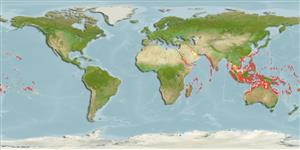Common names from other countries
>
Anguilliformes (Eels and morays) >
Muraenidae (Moray eels) > Muraeninae
Etymology: Gymnothorax: Greek, gymnos = naked + Greek, thorax, -akos = breast (Ref. 45335).
More on author: Bleeker.
Environment: milieu / climate zone / depth range / distribution range
Ecologia
marinhas associadas(os) a recifes; intervalo de profundidade 0 - 50 m (Ref. 30573). Tropical; 30°N - 25°S
Indo-Pacific: Red Sea and East Africa (Ref. 33390) to the Marquesas and Oeno Atoll (Pitcairn Group), north to the Ryukyu and Hawaiian islands, south to New Caledonia and the Austral Islands.
Tamanho / Peso / Idade
Maturity: Lm ? range ? - ? cm
Max length : 300 cm TL macho/indeterminado; (Ref. 9710); peso máx. publicado: 30.0 kg (Ref. 30404)
Espinhos dorsais (total) : 0; Espinhos anais: 0; Vértebras: 137 - 143. Juveniles are tan with numerous large black spots. Adults have black specks that grade into leopard-like spots behind the head and a black area surrounding the gill opening.
Found in lagoon and seaward reefs. Commonly seen species along deep drop-offs and slopes in Indonesian waters (Ref. 48635). Benthic (Ref. 58302). Juveniles more secretive and occur on intertidal reef flats (Ref. 37816). It feeds primarily on fishes and occasionally on crustaceans. This is the largest Indo-Pacific moray eel (Ref. 30404), perhaps reaching 3 m in length. Because of its position at the top of the reef's food chain it is often ciguatoxic. Attacks humans when provoked (Ref. 3132). Minimum depth reported taken from Ref. 10713. Solitary in reef holes (Ref 90102).
Ciclo de vida ou comportamento de acasalamento
Maturities | Reprodução | Spawnings | Egg(s) | Fecundities | Larvas
Observations on prespawning behavior include a pair entwined around one another lying on the bottom of the reef area (Ref. 93344).
Chen, H.-M., K.-T. Shao and C.T. Chen, 1994. A review of the muraenid eels (Family Muraenidae) from Taiwan with descriptions of twelve new records. Zool. Stud. 33(1):44-64. (Ref. 6934)
Status na Lista Vermelha da UICN (Ref. 130435)
CITES (Ref. 128078)
Not Evaluated
Ameaça para os humanos
Reports of ciguatera poisoning (Ref. 4690)
Uso pelos humanos
Pescarias: pesca de subsistência; Aquário: Aquários públicos
Ferramentas
Relatórios especiais
Baixar XML
Fontes da internet
Estimates based on models
Preferred temperature (Ref.
115969): 25.5 - 29, mean 28.1 (based on 902 cells).
Índice de diversidade filogenética (Ref.
82804): PD
50 = 0.5000 [Uniqueness, from 0.5 = low to 2.0 = high].
Bayesian length-weight: a=0.00052 (0.00033 - 0.00084), b=3.27 (3.14 - 3.40), in cm Total Length, based on LWR estimates for this species & Genus-body shape (Ref.
93245).
Nível Trófico (Ref.
69278): 3.9 ±0.64 se; based on food items.
Resiliência (Ref.
120179): Elevada, tempo mínimo de duplicação da população menor que 15 meses (Fec = 200,000-300,000).
Fishing Vulnerability (Ref.
59153): Very high vulnerability (90 of 100).
